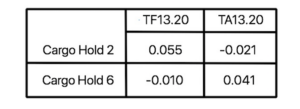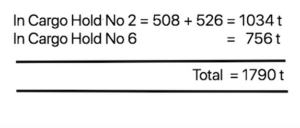Trimming calculations with trimming tables
Prior carrying the trimming calculations, it is important that you take account of the following 3 things
- Be fully aware of the limiting draft of the ship. The limiting draft of the ship could be dependent upon restrictions at load port, discharge port, load line zones, intermediate port such as bunkering port or canal transit etc. The point is that the ship’s officer must be fully conversant with the limiting draft of the ship.
- Always take into account few centimeters of sag allowance esp for ship’s of larger size and/or loading high density cargoes. Note that a prudent Chief Mate will always take into account sag allowance in order to prevent overloading of ship. Overloading can lead to numerous problems for a ship.
- Always take penultimate holds (and not the extreme holds) for trimming esp for Panamax and above size. For ships having 5 holds, end holds shall be used. Although, this rule is not fixed and any hold can be used for carrying out trimming operations – depending upon the final trim requirement and/or space available in the holds.
Having said above, sufficient amount of trimming quantity shall be kept in hand for final trimming. This quantity shall be increased especially while loading in ports where the shore scale is not frequent calibrated and the wrong calibration might result in reduction in planned trimming quantity (as due to error the shore may load excess cargo).
Let us assume the case of Panamax Bulk carrier having 7 cargo holds. The intermediate Draft Survey is done and vessel has arrived at the trimming stage.
The drafts obtained are –
Ford: 13.00 mtrs
Aft: 13.40 mtrs
Mid: 13.22 mtrs
The ship has trim of 0.40 mtrs and SAG of 2 cms.
The limiting draft of the ship is 13.482 mtrs and ship needs to finish loading on an Even Keel.
__________________________
Step 1: Calculate the Cargo which can be loaded by calculating the Sinkage
Sinkage means how much more the ship can be submerged in the water by loading cargo such that it comes to the limiting draft.
Sinkage has a simple formula –
Sinkage Available = Limiting draft – Current Midship draft – Sag allowance
Note that the Current Midship draft is the VISUAL draft being noted and not the Mean draft of the ship. In this case, it is 13.22 mtrs.
Hence Sinkage Available = 13.482 – 13.220 = 0.262 mtrs or 26.2 cms.
I have not taken any SAG allowance, but if in your experience particularly when loading High Density Cargoes always take few cms of Sag allowance. It will aid you to not to overload the ship.
After calculating the sinkage, let us calculate how much cargo which will result in that sinkage.
Cargo to load = Sinkage Available (in cms) x TPC
= 26.2 x 68.30 = 1789.46 tonnes ~ 1790 tonnes of cargo.
The TPC value used is the one specified for your hydrostatic draft.
Now it’s time to know what are Trimming Tables
_________________________________
Trimming Tables
Trimming tables gives effect on ship’s fore and aft draft when 100 MT of cargo is loaded into a certain compartment. Trimming tables can be a part of Trim and Stability Booklet or can be provided separately. Ship officers shall well familiarize themselves with usage of trimming tables as different shipyards can present the data in such tables in different formats.
Once such format is specified below belonging to a bulk carrier. Note that Cargo Hold 1~5 are not mentioned explicitly but instead they are named R.1.01 ~ R.1.05.
However we shall keep things simple and use proper names for the compartment. In this problem I intend to use Cargo Hold 2 and 6 for trimming so this is how the data for the same will look like –

Above data shows the effect on forward drafts when 100 mt of cargo is loaded into a cargo hold no 2 and 6. The words TF and TA states the correction for Forward and Aft draft respectively. While the numbers following 11,12,13,14 is the mean draft of the ship which is used to enter the tables.
As per the table if 100 tonnes of Cargo is loaded in Cargo Hold No 2 for ship at mean draft of 11.00 mtrs the Forward draft will increase by 0.056 mtrs and Aft draft will decrease by -0.022 mtrs. Similarly, for mean draft of 12 mtrs if 100 tonnes of cargo is loaded in Hold No 6 the Forward draft will decrease by 0.011 mtrs and Aft draft will increase by 0.041. The negative sign means that the correction shall be subtracted (draft is reduced) and positive sign means correction shall be added (draft is increased).
Moving on, the ship has a mean draft of 13.20 mtrs ((13.00 + 13.40)/2 = 13.20) and therefore we need to interpolate between the values of 13 and 14 mtrs as shown –

On interpolation we get the following values –

So let us move on to our next step.
________________
Step 2: Calculate total trim change caused by the holds in which cargo is being loaded
This is done by making a simple table as follows –

n this table we are finding out the change of trim – obtained by taking a difference of the ford and aft sinkage values. The important thing to note here is we have to KEEP the signs active.
Note in the case of Cargo Hold No 2 – the corrections are actually added when the difference is taken and similar case is with the values of Cargo hold No 6. The total change of trim is obtained by ADDING values for both holds as shown in red box.
_____________
Step No 3: Calculating cargo to load in 1st Hold (Hold No 2)
Now we have to calculate the quantity we shall load in Cargo Hold no 2. The ship presently has a trim of 0.40 mtrs by stern. Our first aim is to bring the ship to Even Keel. This can be achieved only by loading certain quantity of cargo in Hold 2 such that it causes a trim change of 0.40 mtrs by head and brings the ship to even keel. This can be calculated by using the following formula –

So as you can see we need to load 526 tonnes of cargo in Hold No 2 in order to bring the ship to even keel.
_____________________
Step 4: Calculate the cargo to be loaded in Second Hold (Hold No 6)
From above we know that 526 tonnes is to be loaded in Hold 2. So the balance cargo to load is
1790 – 526 = 1264 tonnes
Now this cargo needs to be distributed in Hold 2 and Hold 6 such that the ship is loaded to her limiting draft and NO TRIM CHANGE IS CAUSED (as we need the ship to finish loading on an even keel). Let us first calculate the cargo which can be loaded into HOLD NO 2.
This can be calculated by the following formula

Alternatively you can calculate the Cargo to load in Hold No 6 by using the same formula only but replacing the “Change of trim caused by #6” with “Change in trim caused by cargo hold #2”. Going by above; if say 508 tonnes of cargo is to be loaded in Hold No 2, then balance cargo to be loaded in Hold No 6 is –
1264 – 508 = 756 tonnes (to be loaded in Hold 6)
Summarizing above results –

Cargo Hold No 2 needs to load 508 tonnes to bring the ship to even keel. Thereafter, Hold No 2 and Hold No 6 needs to load 526 tonnes and 756 tonnes respectively in order to bring the ship to her draft while keeping the trim same ie Even Keel. This calculation needs to be done prior carrying out the Trimming and therefore the calculations shall always be checked and re-checked. Keeping these formulas in mind will save you a lot of time.